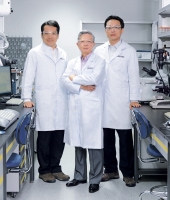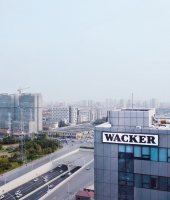Production
Year-on-Year Increase in Production Output
In 2013, production output increased compared with the previous year. WACKER POLYSILICON sold higher volumes than ever before. Our chemical divisions, too, saw their volumes increase and capacity utilization reach a high level. Capacity utilization at the chemical divisions was in excess of 80 percent. There were no major facility shutdowns. Production costs were up 5 percent. Maintenance costs were at prior-year levels and totaled € 355 million.
Plant-Capacity Utilization in 2013
| Download XLS |
|
|
||
|
% |
Plant Utilization |
|
|
|
|
|
|
WACKER SILICONES |
90 |
|
|
WACKER POLYMERS |
82 |
|
|
WACKER POLYSILICON |
90 |
|
|
SILTRONIC |
77 |
|
Investments in new production facilities amounted to € 503.7 million in 2013, with most funds flowing into the expansion of our polysilicon facilities in the US state of Tennessee, where a new polysilicon production site has been under construction since April 2011.
We have built two new plants for WACKER POLYMERS and WACKER BIOSOLUTIONS at our Nanjing site in China. The WACKER POLYMERS plant, for the production of VAE dispersions, has already been started up. It has an annual capacity of 60,000 metric tons. The new VAE dispersion facility at our site in Ulsan, South Korea, is now also operational. Capacity there was increased by 40,000 metric tons. We have stepped up production capacity for VAE dispersions at our site in Calvert City (USA) by 30,000 metric tons. The new WACKER BIOSOLUTIONS plant for polyvinyl acetate solid resins is scheduled to start production in 2014.
Key Start-Ups
| Download XLS |
|
|
||||
|
Location |
Projects |
Start-Up |
||
|
|
|
|
||
|
Nanjing |
VAE dispersions |
2013 |
||
|
Ulsan |
VAE dispersions |
2013 |
||
|
Calvert City |
VAE dispersions |
2013 |
||
Corporate Engineering is responsible for implementing all investment projects at WACKER.
Productivity Program Targets Lower Raw-Material Consumption and Higher Energy Efficiency
High productivity throughout the supply chain is a key to WACKER’s success. WACKER boosts productivity along the entire supply chain via its Wacker Operating System (WOS) program. Our goal is to continue to reduce specific operating costs every year. 2013 saw the implementation of more than 900 projects at our operating divisions and corporate departments. Almost 650 of these concerned our operating divisions, with the corporate departments accounting for 250. Last year, the focus of WOS was on improving specific energy consumption, raw-material yields and plant utilization levels.
Productivity Projects According to Focus

During the year under review, our WOS ACADEMY (founded in 2009) held nine training courses at which some 100 employees were trained in the application of new productivity methods, such as Six Sigma.




